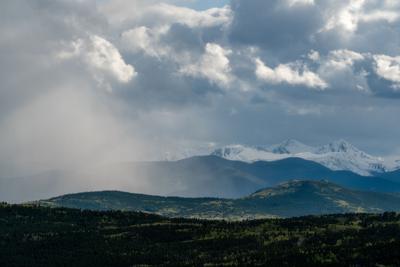The winter and snowstorms are mostly over, but that means it's time to be aware of spring and summer weather hazards in Colorado.
Here are some weather hazards present in Colorado during this time of the year, and some tips on how to stay safe if you encounter these conditions:
1. Lightning
According to the National Weather Service (NWS), about 500,000 lightning flashes hit the ground in Colorado in an average year. Data from 1980 shows that lightning causes two fatalities and 12 injuries per year in Colorado.
When recreating outdoors, it's important to watch the horizon and be aware of incoming storms. According to the National Park Service, if you do get caught in a storm, avoid mountain tops and ridgelines, cliffs and rocky overhangs, wide, open areas including lakes, creeks and boggy ground, and tall, isolated trees. If you're camping, get away from your tent, as it has metal poles that could attract lightning. Relocate to a grove of trees.
As a last resort, you should crouch down or sit on top of a backpack, put your hands behind your head and bend forward. Shelter for at least 30 minutes after the last sound of thunder.
2. Hail
Colorado is very prone to hail, and it can do a lot of damage.
If you get caught in a hailstorm while outdoors, seek whatever shelter you can find immediately. According to the U.S. Forest Service, if you can't find something to shield your entire body, find something to at least protect your head. Be sure to stay out of culverts and lowland area, as they might suddenly fill with water.
3. Monsoon rain
Monsoon season usually begins in late July or early August. Always check the weather forecast before heading outdoors and keep an eye on the sky and watch for approaching storms. Do your best to avoid getting caught in a storm.
Making sure you've got a waterproof layer can be crucial for staying warm and dry should a sudden storm pop up.
4. Mudslides
According to the Centers for Disease Control and Prevention, mudslides can be activated by natural disasters, and areas where wildfires or human modification of the land have occurred are particularly vulnerable. Be aware of steep slopes and other areas that are prone to landslides. Also pay attention to any sudden increase or decrease in water level on nearby streams and creeks. If you are caught in the path of a mudslide, move to the nearest high ground away from the slide's path.
It's also worth noting that if you see a few pebbles falling down the side of the trail, larger rocks may follow. Be aware of what's above you.
5. Flash floods
Flash floods are also a common weather hazard in Colorado, mostly during warmer months of the year. According to the National Weather Service, flash floods have killed nearly 300 Coloradans since 1900. Be aware of the weather and know your flash flood risks, especially if you are near a river or creek. In the event of a flash flood, if you're in a drainage area or other low spot, move to higher ground. According to the NWS, many flash flood deaths occur in vehicles, so never drive through flooded roadways.







(0) comments
Welcome to the discussion.
Log In
Keep it Clean. Please avoid obscene, vulgar, lewd, racist or sexually-oriented language.
PLEASE TURN OFF YOUR CAPS LOCK.
Don't Threaten. Threats of harming another person will not be tolerated.
Be Truthful. Don't knowingly lie about anyone or anything.
Be Nice. No racism, sexism or any sort of -ism that is degrading to another person.
Be Proactive. Use the 'Report' link on each comment to let us know of abusive posts.
Share with Us. We'd love to hear eyewitness accounts, the history behind an article.